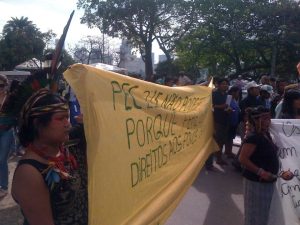
One of the noticeable things here in Rio is that it’s not one summit but three.
At the far Western end of the city in a complex of pavilions is the official inter-governmental summit. The site also holds “side events” run by UN bodies and NGOs who are trying desperately to lobby governments and the UN.
Twenty minutes drive along the beach, near places you will know from elevator music (Ipanema and Copacabana), is a conference largely inhabited by smartly-dressed business people talking about “corporate sustainability”.
Another twenty minutes away in the heart of the old city in Flamengo Park is the “People’s Summit”. Here the dispossessed of the world crowd into marquees, queuing to speak about inequality, deforestation and “land-grabs”.
What is striking is the completely different feel of the three venues.
The first has a steady, measured feel, with talk of texts and clauses, brackets and deletions.
The second is about pressing flesh and swapping business cards – an American colleague who works as an activist-professor said she’d never seen so many people who looked dead inside.
The third has a chaotic yet vibrant feel – political passion mixed with music, indigenous peoples, street performers and impromptu rallies.
Each is as far from the other culturally as it is politically.
Their physical separation seems somehow to underline the starkly different worlds they are hoping will be created.
I remark as much to Arnold, a middle-aged white South African academic.
“Perhaps,” he says. “But you know, we can move between all three worlds. We are as comfortable in one as the other.”
I’m not quite sure who the “we” is, but I hope he’s right that there are people who can bridge these different worlds.
Because if addressing the state of the planet is like climbing a mountain, it’s so much harder when the mountain has three summits.











